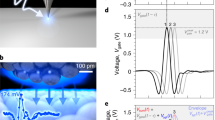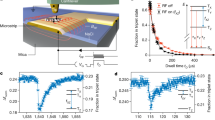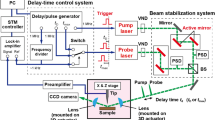Abstract
Scanning probe techniques can leverage atomically precise forces to sculpt matter at surfaces, atom by atom. These forces have been applied quasi-statically to create surface structures1,2,3,4,5,6,7 and influence chemical processes8,9, but exploiting local dynamics10,11,12,13,14 to realize coherent control on the atomic scale remains an intriguing prospect. Chemical reactions15,16,17, conformational changes18,19 and desorption20 have been followed on ultrafast timescales, but directly exerting femtosecond forces on individual atoms to selectively induce molecular motion has yet to be realized. Here we show that the near field of a terahertz wave confined to an atomically sharp tip provides femtosecond atomic-scale forces that selectively induce coherent hindered rotation in the molecular frame of a bistable magnesium phthalocyanine molecule. Combining lightwave-driven scanning tunnelling microscopy21,22,23,24 with ultrafast action spectroscopy10,13, we find that the induced rotation modulates the probability of the molecule switching between its two stable adsorption geometries by up to 39 per cent. Mapping the response of the molecule in space and time confirms that the force acts on the atomic scale and within less than an optical cycle (that is, faster than an oscillation period of the carrier wave of light). We anticipate that our strategy might ultimately enable the coherent manipulation of individual atoms within single molecules or solids so that chemical reactions and ultrafast phase transitions can be manipulated on their intrinsic spatio-temporal scales.
This is a preview of subscription content, access via your institution
Access options
Access Nature and 54 other Nature Portfolio journals
Get Nature+, our best-value online-access subscription
$29.99 / 30 days
cancel any time
Subscribe to this journal
Receive 51 print issues and online access
$199.00 per year
only $3.90 per issue
Buy this article
- Purchase on Springer Link
- Instant access to full article PDF
Prices may be subject to local taxes which are calculated during checkout




Similar content being viewed by others
Data availability
The data supporting the findings of this study are available from the corresponding authors upon request.
References
Hla, S.-W., Bartels, L., Meyer, G. & Rieder, K.-H. Inducing all steps of a chemical reaction with the scanning tunneling microscope tip: towards single molecule engineering. Phys. Rev. Lett. 85, 2777–2780 (2000).
Heinrich, A. J., Lutz, C. P., Gupta, J. A. & Eigler, D. M. Molecule cascades. Science 298, 1381–1387 (2002).
Stroscio, J. A. & Celotta, R. J. Controlling the dynamics of a single atom in lateral atom manipulation. Science 306, 242–247 (2004).
Ternes, M., Lutz, C. P., Hirjibehedin, C. F., Giessibl, F. J. & Heinrich, A. J. The force needed to move an atom on a surface. Science 319, 1066–1069 (2008).
Pavliček, N. et al. Synthesis and characterization of triangulene. Nat. Nanotechnol. 12, 308–311 (2017).
García-López, V. et al. Molecular machines open cell membranes. Nature 548, 567–572 (2017).
Esat, T., Friedrich, N., Tautz, F. S. & Temirov, R. A standing molecule as a single-electron field emitter. Nature 558, 573–576 (2018).
Garcia-Manyes, S. & Beedle, A. E. M. Steering chemical reactions with force. Nat. Rev. Chem. 1, 0083 (2017).
Ladenthin, J. N. et al. Force-induced tautomerization in a single molecule. Nat. Chem. 8, 935–940 (2016).
Wu, S. & Ho, W. Two-photon-induced hot-electron transfer to a single molecule in a scanning tunneling microscope. Phys. Rev. B 82, 085444 (2010).
Lee, J., Perdue, S. M., Rodriguez Perez, A. & Apkarian, V. A. Vibronic motion with joint angstrom-femtosecond resolution observed through Fano progressions recorded within one molecule. ACS Nano 8, 54–63 (2014).
Yampolsky, S. et al. Seeing a single molecule vibrate through time-resolved coherent anti-Stokes Raman scattering. Nat. Photon. 8, 650–656 (2014).
Li, S., Chen, S., Li, J., Wu, R. & Ho, W. Joint space-time coherent vibration driven conformational transitions in a single molecule. Phys. Rev. Lett. 119, 176002 (2017).
Lee, J., Crampton, K. T., Tallarida, N. & Apkarian, V. A. Visualizing vibrational normal modes of a single molecule with atomically confined light. Nature 568, 78–82 (2019).
Wörner, H. J., Bertrand, J. B., Kartashov, D. V., Corkum, P. B. & Villeneuve, D. M. Following a chemical reaction using high-harmonic interferometry. Nature 466, 604–607 (2010).
Wolter, B. et al. Ultrafast electron diffraction imaging of bond breaking in di-ionized acetylene. Science 354, 308–312 (2016).
Elsaesser, T. Introduction: ultrafast processes in chemistry. Chem. Rev. 117, 10621–10622 (2017).
Prokhorenko, V. I. et al. Coherent control of retinal isomerization in bacteriorhodopsin. Science 313, 1257–1261 (2006).
Böckmann, H. et al. Near-field spectral response of optically excited scanning tunneling microscope junctions probed by single-molecule action spectroscopy. J. Phys. Chem. Lett. 10, 2068–2074 (2019).
Dürr, M., Biedermann, A., Hu, Z., Höfer, U. & Heinz, T. F. Probing high-barrier pathways of surface reactions by scanning tunneling microscopy. Science 296, 1838–1841 (2002).
Cocker, T. L. et al. An ultrafast terahertz scanning tunnelling microscope. Nat. Photon. 7, 620–625 (2013).
Cocker, T. L., Peller, D., Yu, P., Repp, J. & Huber, R. Tracking the ultrafast motion of a single molecule by femtosecond orbital imaging. Nature 539, 263–267 (2016).
Yoshioka, K. et al. Real-space coherent manipulation of electrons in a single tunnel junction by single-cycle terahertz electric fields. Nat. Photon. 10, 762–765 (2016).
Jelic, V. et al. Ultrafast terahertz control of extreme tunnel currents through single atoms on a silicon surface. Nat. Phys. 13, 591–598 (2017).
Miwa, K., Imada, H., Kawahara, S. & Kim, Y. Effects of molecule-insulator interaction on geometric property of a single phthalocyanine molecule adsorbed on an ultrathin NaCl film. Phys. Rev. B 93, 165419 (2016).
Patera, L. L., Queck, F., Scheuerer, P., Moll, N. & Repp, J. Accessing a charged intermediate state involved in the excitation of single molecules. Phys. Rev. Lett. 123, 016001 (2019).
Jahng, J. et al. Ultrafast pump-probe force microscopy with nanoscale resolution. Appl. Phys. Lett. 106, 083113 (2015).
Schumacher, Z., Spielhofer, A., Miyahara, Y. & Grutter, P. The limit of time resolution in frequency modulation atomic force microscopy by a pump-probe approach. Appl. Phys. Lett. 110, 053111 (2017).
Eichberger, M. et al. Snapshots of cooperative atomic motions in the optical suppression of charge density waves. Nature 468, 799–802 (2010).
Scholes, G. D. et al. Using coherence to enhance function in chemical and biophysical systems. Nature 543, 647–656 (2017).
Alemani, M. et al. Electric field-induced isomerization of azobenzene by STM. J. Am. Chem. Soc. 128, 14446–14447 (2006).
Zhang, Y. et al. Simultaneous and coordinated rotational switching of all molecular rotors in a network. Nat. Nanotechnol. 11, 706–712 (2016).
Stipe, B. C., Rezaei, M. A. & Ho, W. Coupling of vibrational excitation to the rotational motion of a single adsorbed molecule. Phys. Rev. Lett. 81, 1263–1266 (1998).
Qiu, X. H., Nazin, G. V. & Ho, W. Mechanisms of reversible conformational transitions in a single molecule. Phys. Rev. Lett. 93, 196806 (2004).
Liljeroth, P., Repp, J. & Meyer, G. Current-Induced hydrogen tautomerization and conductance switching of naphthalocyanine molecules. Science 317, 1203–1206 (2007).
Blum, V. et al. Ab initio molecular simulations with numeric atom-centered orbitals. Comput. Phys. Commun. 180, 2175–2196 (2009).
Perdew, J. P., Burke, K. & Ernzerhof, M. Generalized gradient approximation made simple. Phys. Rev. Lett. 77, 3865 (1996).
Tkatchenko, A. & Scheffler, M. Accurate molecular Van Der Waals interactions from ground-state electron density and free-atom reference data. Phys. Rev. Lett. 102, 073005 (2009).
Ruiz, V. G., Liu, W., Zojer, E., Scheffler, M. & Tkatchenko, A. Density-functional theory with screened van der Waals interactions for the modeling of hybrid inorganic-organic systems. Phys. Rev. Lett. 108, 146103 (2012).
Chen, C. J. Introduction to Scanning Tunneling Microscopy (Oxford Univ. Press, 1993).
Acknowledgements
We thank C. Meineke, A. Pöllmann, C. Rohrer, J. Hayes and M. Furthmeier for assistance and L. L. Patera for discussions. We acknowledge financial support from the Volkswagen Foundation (Lichtenberg programme) and Deutsche Forschungsgemeinschaft (DFG, German Research Foundation) through Project ID 422 314695032-SFB 1277 (Subproject B02) as well as Research Grant HU1598/3.
Author information
Authors and Affiliations
Contributions
D.P., L.Z.K., T.B., C.R., F.A., R.H. and J.R. conceived, set up and carried out the experiments. N.M. devised and carried out the DFT calculations. D.P., L.Z.K., T.B., C.R., R.H. and J.R. analysed the data and wrote the manuscript. All authors revised the manuscript.
Corresponding authors
Ethics declarations
Competing interests
The authors declare no competing interests.
Additional information
Peer review information Nature thanks Nicholas Camillone and the other, anonymous, reviewer(s) for their contribution to the peer review of this work.
Extended data figures and tables
Extended Data Fig. 1 Time-integrated STM image of recurringly switching MgPc molecule.
Constant-current topographic map of the LUMO resonance of a MgPc molecule adsorbed on NaCl (1.1 V bias voltage, 2 pA current setpoint). The NaCl symmetry directions are indicated by dashed lines. A prominent ring of 4 Å apparent height around the centre of the molecule is visible, featuring four pairs of local minima along the azimuthal direction (one pair indicated by arrows). To record each single pixel, millions of electrons are successively tunnelled from the tip into a molecular orbital and subsequently into the substrate, triggering the molecule to switch between both adsorption ground states \(|l\rangle \) and \(|r\rangle \) many times. As a result, the time-integrated LUMO density map features pairs of local minima deduced from the individual electronic nodal planes in states \(|l\rangle \) and \(|r\rangle \), representing a superposition of the electron density in both geometries.
Extended Data Fig. 2 Path-selective map of the switching probability.
The panels show data for the same experiment and simulation as presented in Fig. 2d, e, but here for the opposite switching direction from \(|r\rangle \) to \(|l\rangle \).
Extended Data Fig. 3 Terahertz field calibration.
The probability of switching triggered by individual terahertz pulses is measured as a function of terahertz field strengths (blue data points). The field strength is controlled by transmitting the pulses through a pair of crossed polarizers and plotted on a linear scale with initially undetermined scaling factor. As the field increases, the peak field of the pulses reaches the LUMO resonance. Assuming a linear relationship between the current resulting from tunnelling through the LUMO and the switching probability, the observed onset in switching probability with increasing field should roughly resemble the onset of the tunnelling current with increasing bias voltage in time-integrated scanning tunnelling spectroscopy. The Gaussian-shaped LUMO-related peak in time-integrated differential conductance (dI/dV) spectra translates into an error-function-shaped onset of current with increasing voltage. Indeed, an error function (erf) fits the experimental data very well (blue fit curve), the derivative of which (red curve, normalized to the peak) reproduces the equivalent of a LUMO-related peak in dI/dV spectra. Time-integrated scanning tunnelling spectroscopy shows that the LUMO resonance is centred at a voltage of 1.2 V, allowing for a calibration of the applied terahertz peak fields in terms of the transient’s peak voltage.
Extended Data Fig. 4 Extraction of mean \(\bar{{\bf{p}}}\) and amplitude ppp from coherently modulated switching probability traces.
In a pump–probe scheme as depicted in Fig. 3a, pairs of terahertz pulses with an adjustable delay time τ induced switching events. Although the field strength of the probe pulses was chosen to facilitate electron tunnelling into the LUMO and thereby trigger switching events, the field strength of the pump pulses was systematically varied. For non-zero pump electric fields the time-resolved switching probability traces p(τ) show oscillations at a frequency of 0.3 THz, one period of which is resolved for different field strengths of the pump pulse. The latter is indicated in the top right corner of each panel, expressed as the peak voltage of the corresponding transient (calibrated via Extended Data Fig. 3). For each curve, the time-averaged mean \(\bar{{p}}\) and amplitude ppp are extracted by fitting a sine (solid lines) to the data.
Extended Data Fig. 5 Field-induced coherence modulates switching probability by 39%.
Time-resolved switching probability versus delay time, obtained in the same way as the data shown in Fig. 3b. Here, the field strength of pump and probe pulses were equal and individually large enough to facilitate tunnelling into the LUMO, which corresponds to a peak value of the corresponding voltage transient of about 1.2 V; see Extended Data Fig. 3. This data exhibits a field-induced modulation of 39%, representing the largest variation that we detected (peak-to-peak modulation of 0.0076 to an average of 0.0195).
Extended Data Fig. 6 Analysis of the role of specific atoms of MgPc and the NaCl substrate in determining the adsorption energetics with respect to the azimuthal orientation.
In DFT calculations we enforce different in-plane rotation angles by fixing one of the in-plane coordinates of two nitrogen atoms of the molecule and the orientation of the substrate while relaxing the remaining geometry. Performing this calculation for several angles allows us to track the response of select atoms to an in-plane rotation of MgPc. a, Pink data points indicate the z coordinate (perpendicular to the surface) of four equivalent hydrogen atoms of the molecule (highlighted in pink in b, top view of molecule and NaCl layers) as a function of adsorption angle and show a clear excursion of the atoms towards the substrate for rotation angles around ϕ = 10° (z coordinates relative to the topmost NaCl layer). Similarly, the z coordinate of the closest Cl– ion (green data points in a and green atoms in b) shows a clear upward deflection at similar angles, suggesting a local interaction between these two atoms. c, d, For comparison, we show the z coordinates of other pairs of H atoms and Cl– ions, which do not exhibit such behaviour. e, f, Further, the z coordinate of four equivalent sodium atoms (intense blue) located below one of the C–C bonds of the molecule’s peripheral benzene rings indicates an excursion towards the molecule of up to almost 0.2 Å for increasing adsorption angles. For comparison, we plot the z coordinates of another sodium atom (light blue), which has an analogous role in the opposing switch position. This atom exhibits an excursion away from the molecule. Notably, all three atoms that feature a strong coupling between their z coordinate and the in-plane rotation of the molecule (pink, intense green, intense blue) are located in the region where local fields induce the strongest coherent excitation (Fig. 4).
Supplementary information
Video 1
Femtosecond video of time-dependent single-molecule reaction statistics. An ultra-slow-motion video visualizes the spatio-temporal evolution of the reaction probability after field driven local excitation of coherent structural dynamics \(({V}_{{\rm{T}}{\rm{H}}{\rm{z}}}^{{\rm{p}}{\rm{u}}{\rm{m}}{\rm{p}}}=0.7\,{\rm{V}})\). Every frame shows a colour-coded snapshot image where the transient-state switching probability pl–r(x, y, τ) is spatially resolved for one specific delay time τ. One period of the oscillatory dynamics (τ = 15.0–18.0 ps) is resolved in time steps of 500 fs and looped. The image size is 24.5 Å × 24.5 Å and a playback time of 1 s corresponds to an experimental delay time of 2.5 ps.
Rights and permissions
About this article
Cite this article
Peller, D., Kastner, L.Z., Buchner, T. et al. Sub-cycle atomic-scale forces coherently control a single-molecule switch. Nature 585, 58–62 (2020). https://doi.org/10.1038/s41586-020-2620-2
Received:
Accepted:
Published:
Issue Date:
DOI: https://doi.org/10.1038/s41586-020-2620-2
This article is cited by
-
Submolecular-scale control of phototautomerization
Nature Nanotechnology (2024)
-
Ultrafast atomic-scale scanning tunnelling spectroscopy of a single vacancy in a monolayer crystal
Nature Photonics (2024)
-
Attosecond electron microscopy of sub-cycle optical dynamics
Nature (2023)
-
Surface interaction propels molecule forwards
Nature (2023)
-
Local cation-tuned reversible single-molecule switch in electric double layer
Nature Communications (2023)
Comments
By submitting a comment you agree to abide by our Terms and Community Guidelines. If you find something abusive or that does not comply with our terms or guidelines please flag it as inappropriate.



